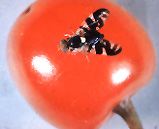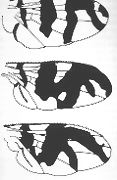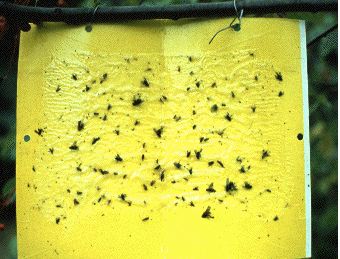
II. Hosts: Cherry, pear, plum, wild cherry. BCFF is reported to prefer sour over sweet cherries; pin cherry is the normal wild host. The normal wild host of CFF is wild black cherry.
III. Description: Male CFF are slightly larger than the females which are slightly smaller than house flies, averaging slightly less than 2/10 inch (4.5 mm). The adult is blackish in color with tinges of yellow on the head and lateral margins of the thorax. There is a whitish dot near the center of the back. The abdomen is marked with four white cross-bands (lacking in BCFF pictured above). Wings are marked with distinct blackish bands. These and related fruit flies vary somewhat in their wing banding patterns; CFF has the pattern in the top wing, pictured below and BCFF has the middle pattern (the wing at the bottom is apple maggot fly).

IV. Biology: The flies lay eggs in cherries which give rise to maggots when they hatch. The pest overwinters as small brown puparia in the soil. To attain maximum emergence approximately 150 days of temperatures between 32 and 40ûF are required. Flies appear in the cherry orchards through June and July where they mate soon after arrival. The BCFF emerges about a week ahead of CFF. There is a 5-10 day preoviposition period during which adults feed on aphid honeydew and other sources. After 5-6 days egg laying commences and can continue for about 25 days. Over 350 eggs may be laid by one female. The eggs hatch into small, legless, headless larvae in about a week. Newly hatched larvae burrow directly into the fruit where they feed. Inside the fruit the larvae continue to grow, passing through three instars each of 11 days duration. Mature larvae are about 1/4 inch (7 mm) long. The final instar larvae develop a breathing hole in the surface of the fruit and after about three days near the surface emerge, drop to the soil and form a new puparium at a depth of approximately 3 inches (7.6 cm). Periods of drought during periods of adult emergence or larval entry into soil will reduce populations.
V. Injury: Infested cherries become shrunken, misshapen and undersized. The fruit turns reddish and ripens earlier than uninfested fruit. Larval tunnels extend throughout the infested fruit.
VI. Monitoring: Monitor cherry fruit flies from mid-season thorough harvest. Place one yellow sticky trap (pictured below) with ammonium acetate bait per 10 acres (4 hectares). Use an action threshold of three flies per trap per week. When flies first appear on traps, their ovaries are still undeveloped, and sprays should be delayed for about a week to target ovipositing females. Repeat in about 10 days. Late varieties may require a third spray. Small larvae in the fruit may be detected more easily by boiling a suspect sample in water for one minute. The larvae then tend to sink to the bottom of the container.

This is taken primarily from a chapter by R. L. Horsburgh on
cherry
direct pests, reprinted
with permission from Mid-Atlantic Orchard Monitoring Guide,
published
by NRAES, 152 Riley-Robb Hall, Ithaca, New York 14853-5701. (607)
255-7654. Other sources: Metcalf, C. L., W. P. Flint
and R.
L. Metcalf. 1962. Destructive and Usedful Insects.
McGraw-Hill.
See factsheets from New York, Michigan, Kentucky, Washington State.